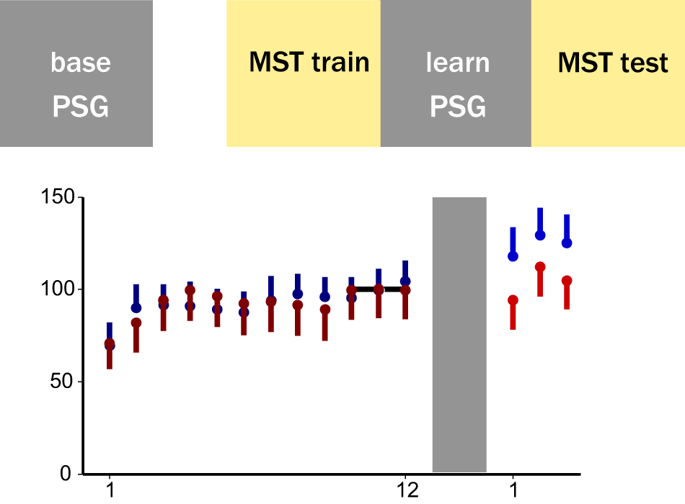当前位置:
X-MOL 学术
›
npj Schizophr.
›
论文详情
Our official English website, www.x-mol.net, welcomes your feedback! (Note: you will need to create a separate account there.)
Distributed slow-wave dynamics during sleep predict memory consolidation and its impairment in schizophrenia.
npj Schizophrenia ( IF 5.4 ) Pub Date : 2019-11-04 , DOI: 10.1038/s41537-019-0086-8 Ullrich Bartsch 1, 2 , Andrew J Simpkin 3 , Charmaine Demanuele 4, 5, 6, 7 , Erin Wamsley 8 , Hugh M Marston 1 , Matthew W Jones 2
npj Schizophrenia ( IF 5.4 ) Pub Date : 2019-11-04 , DOI: 10.1038/s41537-019-0086-8 Ullrich Bartsch 1, 2 , Andrew J Simpkin 3 , Charmaine Demanuele 4, 5, 6, 7 , Erin Wamsley 8 , Hugh M Marston 1 , Matthew W Jones 2
Affiliation

|
The slow waves (SW) of non-rapid eye movement (NREM) sleep reflect neocortical components of network activity during sleep-dependent information processing; their disruption may therefore impair memory consolidation. Here, we quantify sleep-dependent consolidation of motor sequence memory, alongside sleep EEG-derived SW properties and synchronisation, and SW-spindle coupling in 21 patients suffering from schizophrenia and 19 healthy volunteers. Impaired memory consolidation in patients culminated in an overnight improvement in motor sequence task performance of only 1.6%, compared with 15% in controls. During sleep after learning, SW amplitudes and densities were comparable in healthy controls and patients. However, healthy controls showed a significant 45% increase in frontal-to-occipital SW coherence during sleep after motor learning in comparison with a baseline night (baseline: 0.22 ± 0.05, learning: 0.32 ± 0.05); patient EEG failed to show this increase (baseline: 0.22 ± 0.04, learning: 0.19 ± 0.04). The experience-dependent nesting of spindles in SW was similarly disrupted in patients: frontal-to-occipital SW-spindle phase-amplitude coupling (PAC) significantly increased after learning in healthy controls (modulation index baseline: 0.17 ± 0.02, learning: 0.22 ± 0.02) but not in patients (baseline: 0.13 ± 0.02, learning: 0.14 ± 0.02). Partial least-squares regression modelling of coherence and PAC data from all electrode pairs confirmed distributed SW coherence and SW-spindle coordination as superior predictors of overnight memory consolidation in healthy controls but not in patients. Quantifying the full repertoire of NREM EEG oscillations and their long-range covariance therefore presents learning-dependent changes in distributed SW and spindle coordination as fingerprints of impaired cognition in schizophrenia.
中文翻译:

睡眠期间的分布式慢波动力学预测了记忆巩固及其在精神分裂症中的损害。
非快速眼动(NREM)睡眠的慢波(SW)反映了依赖睡眠的信息处理过程中网络活动的新皮质成分;因此,它们的中断可能会损害内存整合。在这里,我们量化了21位精神分裂症患者和19位健康志愿者的睡眠依赖性运动序列记忆整合,以及睡眠脑电图得出的SW特性和同步性以及SW主轴耦合。患者记忆巩固受损导致运动序列任务表现的夜间改善仅为1.6%,而对照组为15%。学习后的睡眠期间,健康对照组和患者的SW振幅和密度可比。然而,健康对照者显示,运动学习后的睡眠过程中额叶至枕骨西南连贯性的增长与基线夜晚相比明显增加(基线:0.22±0.05,学习:0.32±0.05);患者的脑电图未能显示出这种增加(基线:0.22±0.04,学习:0.19±0.04)。患者在心轴中依赖于经验的心轴嵌套也受到类似的破坏:在健康对照中学习后,额枕至心轴-心轴相位-幅度耦合(PAC)显着增加(调制指数基线:0.17±0.02,学习:0.22± 0.02),但不适用于患者(基线:0.13±0.02,学习程度:0.14±0.02)。来自所有电极对的相干性和PAC数据的偏最小二乘回归模型证实,分布的SW相干性和SW轴协调性是健康对照而非患者中过夜记忆巩固的较好预测指标。量化NREM脑电图振荡及其远程协方差的完整组成部分,因此将精神分裂症认知功能受损的指纹图谱和心轴协调性呈现为学习依赖性变化。
更新日期:2019-11-04
中文翻译:

睡眠期间的分布式慢波动力学预测了记忆巩固及其在精神分裂症中的损害。
非快速眼动(NREM)睡眠的慢波(SW)反映了依赖睡眠的信息处理过程中网络活动的新皮质成分;因此,它们的中断可能会损害内存整合。在这里,我们量化了21位精神分裂症患者和19位健康志愿者的睡眠依赖性运动序列记忆整合,以及睡眠脑电图得出的SW特性和同步性以及SW主轴耦合。患者记忆巩固受损导致运动序列任务表现的夜间改善仅为1.6%,而对照组为15%。学习后的睡眠期间,健康对照组和患者的SW振幅和密度可比。然而,健康对照者显示,运动学习后的睡眠过程中额叶至枕骨西南连贯性的增长与基线夜晚相比明显增加(基线:0.22±0.05,学习:0.32±0.05);患者的脑电图未能显示出这种增加(基线:0.22±0.04,学习:0.19±0.04)。患者在心轴中依赖于经验的心轴嵌套也受到类似的破坏:在健康对照中学习后,额枕至心轴-心轴相位-幅度耦合(PAC)显着增加(调制指数基线:0.17±0.02,学习:0.22± 0.02),但不适用于患者(基线:0.13±0.02,学习程度:0.14±0.02)。来自所有电极对的相干性和PAC数据的偏最小二乘回归模型证实,分布的SW相干性和SW轴协调性是健康对照而非患者中过夜记忆巩固的较好预测指标。量化NREM脑电图振荡及其远程协方差的完整组成部分,因此将精神分裂症认知功能受损的指纹图谱和心轴协调性呈现为学习依赖性变化。


























 京公网安备 11010802027423号
京公网安备 11010802027423号